Page 5694 of 6020
9A1-12 RESTRAINT CONTROL SYSTEM
Chart B “SRS” Warning Lamp Comes “ON” Steady
RTW 79ALF000301
Circuit Description
W hen the ignition switch is first turned “ON”, “Ignition 1”
voltage is applied from the “METER” fuse to the “SRS”,
warning lamp which is connected to “SRS W arning
Lamp”, terminal “4”. The “SRS” fuses apply system
voltage to the “Ignition 1” inputs, terminals “1”. The
SRS control unit responds by flashing the “SRS”
warning lamp 7 times. If “Ignition 1” is less than 9 volts,
the “SRS” warning lamp will come “ON” solid with no
DTCs set.
Chart Test Description
Number(s) below refer to step number(s) on the
diagnostic chart:
2. This test checks for an open in the “Ignition 1” circuit to the SRS control unit.
3. This test checks for the voltage of “Ignition 1”.
4. This test determines whether the malfunction is a short to ground in the SRS warning lamp circuit.
BACK TO CHAPTER INDEX TO MODEL INDEX
ISUZU KB P190 2007
Page 5696 of 6020
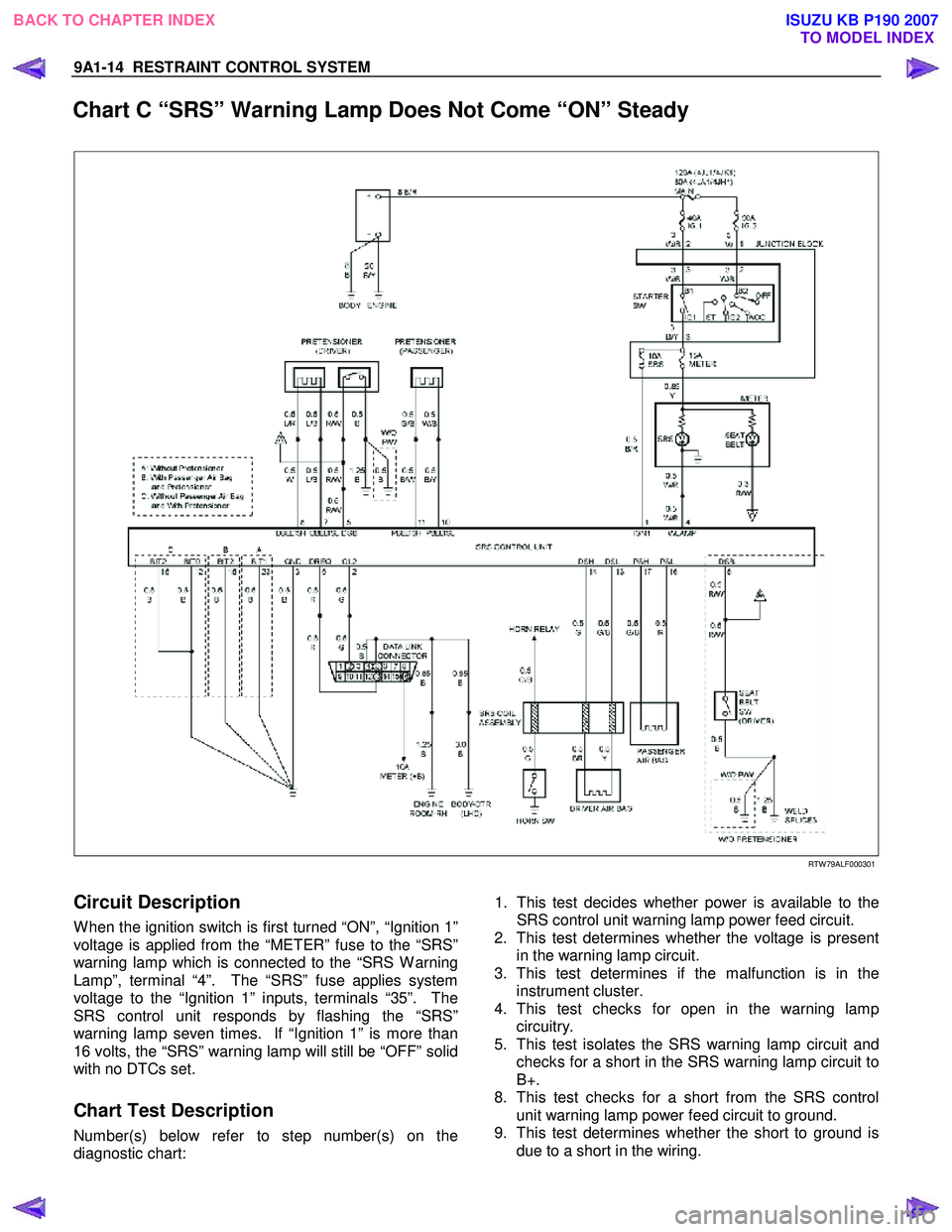
9A1-14 RESTRAINT CONTROL SYSTEM
Chart C “SRS” Warning Lamp Does Not Come “ON” Steady
RTW 79ALF000301
Circuit Description
W hen the ignition switch is first turned “ON”, “Ignition 1”
voltage is applied from the “METER” fuse to the “SRS”
warning lamp which is connected to the “SRS W arning
Lamp”, terminal “4”. The “SRS” fuse applies system
voltage to the “Ignition 1” inputs, terminals “35”. The
SRS control unit responds by flashing the “SRS”
warning lamp seven times. If “Ignition 1” is more than
16 volts, the “SRS” warning lamp will still be “OFF” solid
with no DTCs set.
Chart Test Description
Number(s) below refer to step number(s) on the
diagnostic chart:
1. This test decides whether power is available to the
SRS control unit warning lamp power feed circuit.
2. This test determines whether the voltage is present
in the warning lamp circuit.
3. This test determines if the malfunction is in the
instrument cluster.
4. This test checks for open in the warning lamp
circuitry.
5. This test isolates the SRS warning lamp circuit and
checks for a short in the SRS warning lamp circuit to
B+.
8. This test checks for a short from the SRS control
unit warning lamp power feed circuit to ground.
9. This test determines whether the short to ground is
due to a short in the wiring.
BACK TO CHAPTER INDEX TO MODEL INDEX
ISUZU KB P190 2007
Page 5699 of 6020
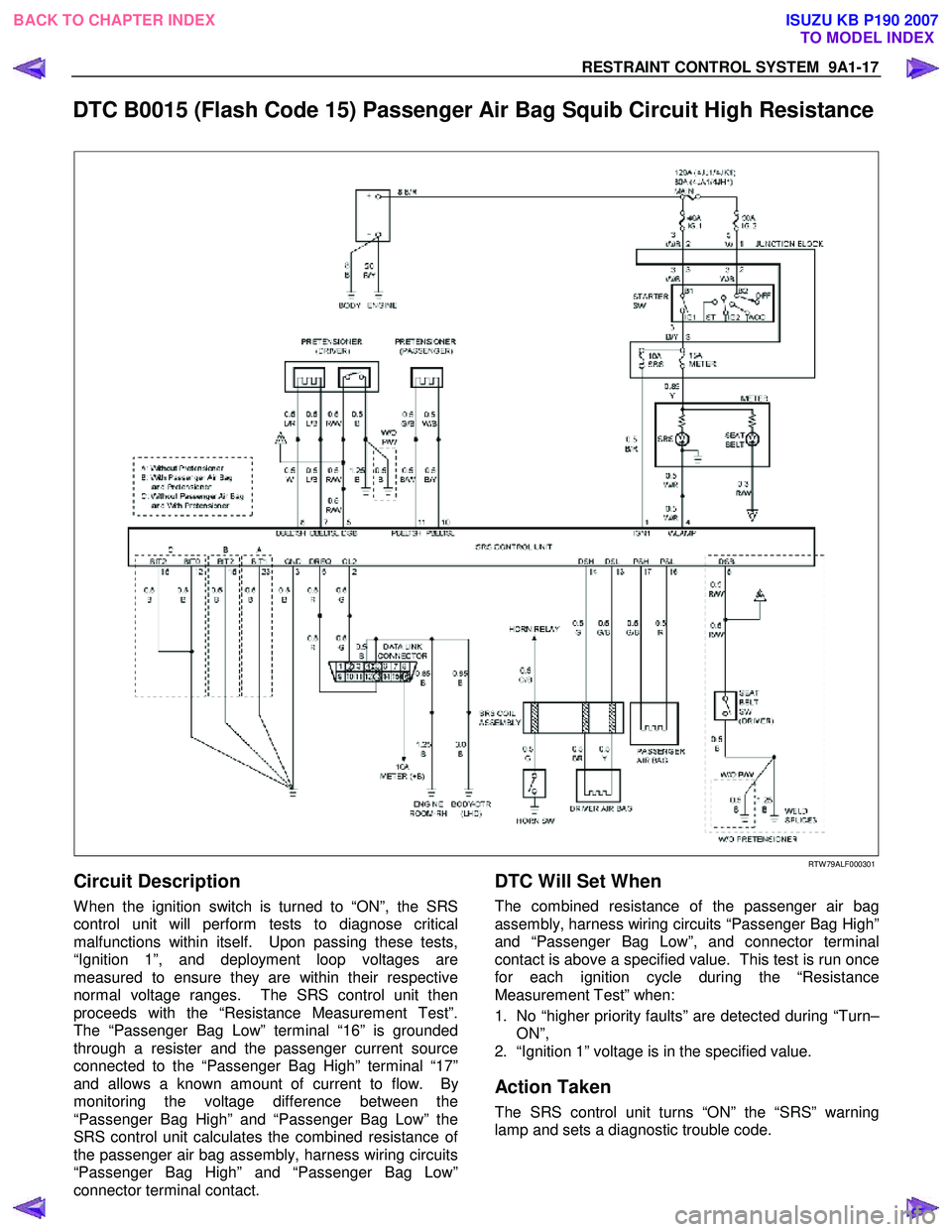
RESTRAINT CONTROL SYSTEM 9A1-17
DTC B0015 (Flash Code 15) Passenger Air Bag Squib Circuit High Resistance
RTW 79ALF000301
Circuit Description
W hen the ignition switch is turned to “ON”, the SRS
control unit will perform tests to diagnose critical
malfunctions within itself. Upon passing these tests,
“Ignition 1”, and deployment loop voltages are
measured to ensure they are within their respective
normal voltage ranges. The SRS control unit then
proceeds with the “Resistance Measurement Test”.
The “Passenger Bag Low” terminal “16” is grounded
through a resister and the passenger current source
connected to the “Passenger Bag High” terminal “17”
and allows a known amount of current to flow. B
y
monitoring the voltage difference between the
“Passenger Bag High” and “Passenger Bag Low” the
SRS control unit calculates the combined resistance o
f
the passenger air bag assembly, harness wiring circuits
“Passenger Bag High” and “Passenger Bag Low”
connector terminal contact.
DTC Will Set When
The combined resistance of the passenger air bag
assembly, harness wiring circuits “Passenger Bag High”
and “Passenger Bag Low”, and connector terminal
contact is above a specified value. This test is run once
for each ignition cycle during the “Resistance
Measurement Test” when:
1. No “higher priority faults” are detected during “Turn–
ON”,
2. “Ignition 1” voltage is in the specified value.
Action Taken
The SRS control unit turns “ON” the “SRS” warning
lamp and sets a diagnostic trouble code.
BACK TO CHAPTER INDEX TO MODEL INDEX
ISUZU KB P190 2007
Page 5702 of 6020
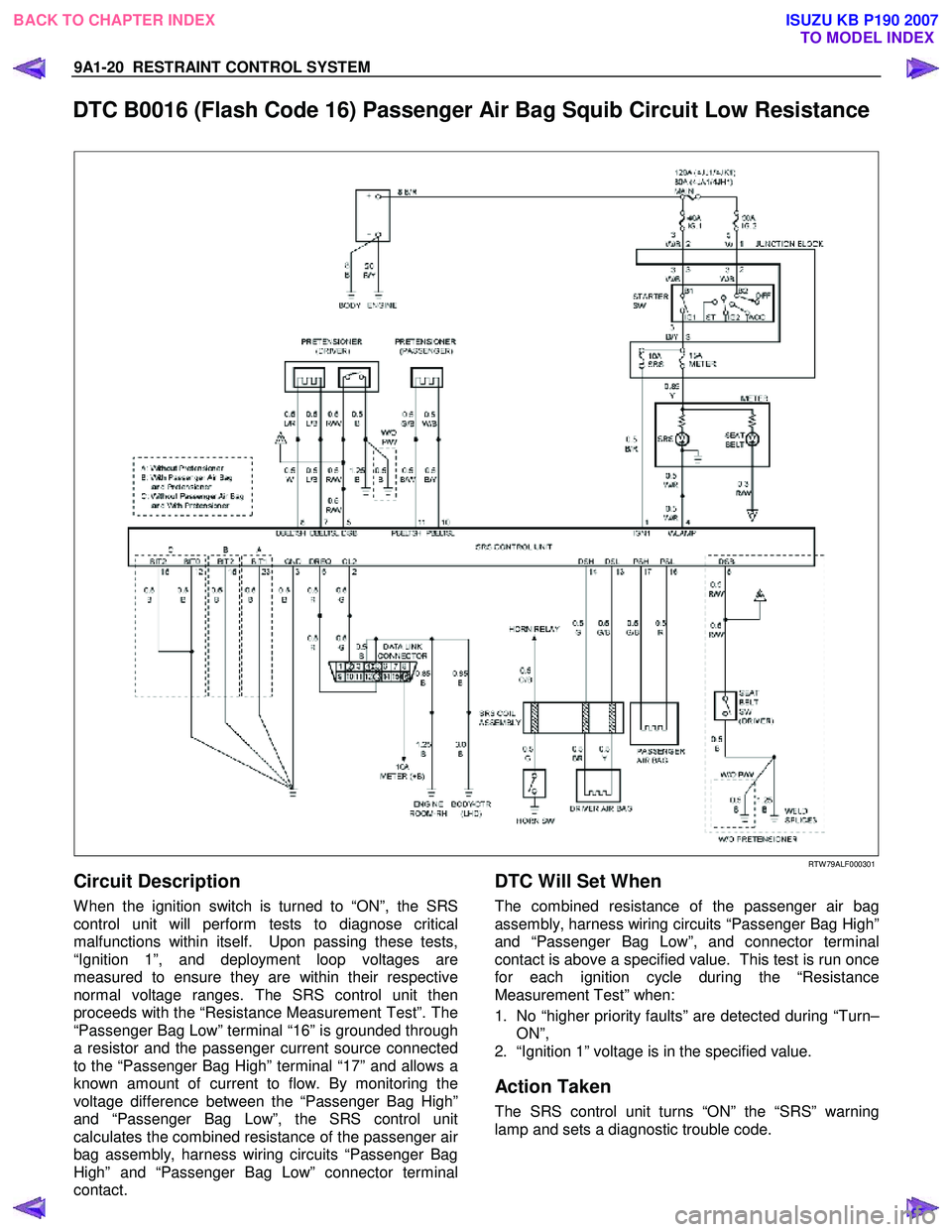
9A1-20 RESTRAINT CONTROL SYSTEM
DTC B0016 (Flash Code 16) Passenger Air Bag Squib Circuit Low Resistance
RTW 79ALF000301
Circuit Description
W hen the ignition switch is turned to “ON”, the SRS
control unit will perform tests to diagnose critical
malfunctions within itself. Upon passing these tests,
“Ignition 1”, and deployment loop voltages are
measured to ensure they are within their respective
normal voltage ranges. The SRS control unit then
proceeds with the “Resistance Measurement Test”. The
“Passenger Bag Low” terminal “16” is grounded through
a resistor and the passenger current source connected
to the “Passenger Bag High” terminal “17” and allows a
known amount of current to flow. By monitoring the
voltage difference between the “Passenger Bag High”
and “Passenger Bag Low”, the SRS control unit
calculates the combined resistance of the passenger ai
r
bag assembly, harness wiring circuits “Passenger Bag
High” and “Passenger Bag Low” connector terminal
contact.
DTC Will Set When
The combined resistance of the passenger air bag
assembly, harness wiring circuits “Passenger Bag High”
and “Passenger Bag Low”, and connector terminal
contact is above a specified value. This test is run once
for each ignition cycle during the “Resistance
Measurement Test” when:
1. No “higher priority faults” are detected during “Turn– ON”,
2. “Ignition 1” voltage is in the specified value.
Action Taken
The SRS control unit turns “ON” the “SRS” warning
lamp and sets a diagnostic trouble code.
BACK TO CHAPTER INDEX TO MODEL INDEX
ISUZU KB P190 2007
Page 5705 of 6020
RESTRAINT CONTROL SYSTEM 9A1-23
DTC B0018 (Flash Code 18) Passenger Air Bag Squib Circuit Short to GND
RTW 79ALF000301
Circuit Description
W hen the ignition switch is turned “ON”, the SRS
control unit will perform tests to diagnose critical
malfunctions within itself. Upon passing these tests,
“Ignition 1”, and the deployment loop voltages are
measured to ensure they are within their respective
normal voltage ranges.
The SRS control unit monitors the voltages at the
“Driver Bag Low” terminal “13” and “Passenger Bag
Low” terminal “16” to detect short to ground/+B in the ai
r
bag assembly circuits.
DTC Will Set When
“Ignition 1" is within the normal operating voltage range.
The voltage at “Passenger Bag Low" is below a
specified value DTC B0018 will set.
Action Taken
The SRS control unit turns “ON” the “SRS” warning
lamp and sets a diagnostic trouble code.
BACK TO CHAPTER INDEX TO MODEL INDEX
ISUZU KB P190 2007
Page 5708 of 6020
9A1-26 RESTRAINT CONTROL SYSTEM
DTC B0019 (Flash Code 19) Passenger Air Bag Squib Circuit Short to Battery
Voltage
RTW 79ALF000301
Circuit Description
W hen the ignition switch is turned “ON”, the SRS
control unit will perform tests to diagnose critical
malfunctions within itself. Upon passing these tests,
“Ignition 1”, and the deployment loop voltages are
measured to ensure they are within their respective
normal voltage ranges.
The SRS control unit monitors the voltages at the
“Driver Bag Low” terminal “13” and “Passenger Bag
Low” terminal “16” to detect short to ground/+B in the ai
r
bag assembly circuits.
DTC Will Set When
“Ignition 1" is in the normal operating voltage range.
The voltage at “Passenger Bag Low" is above a
specified value,
DTC B0019 will set.
Action Taken
The SRS control unit turns “ON” the “SRS” warning
lamp and sets a diagnostic trouble code.
BACK TO CHAPTER INDEX TO MODEL INDEX
ISUZU KB P190 2007
Page 5710 of 6020
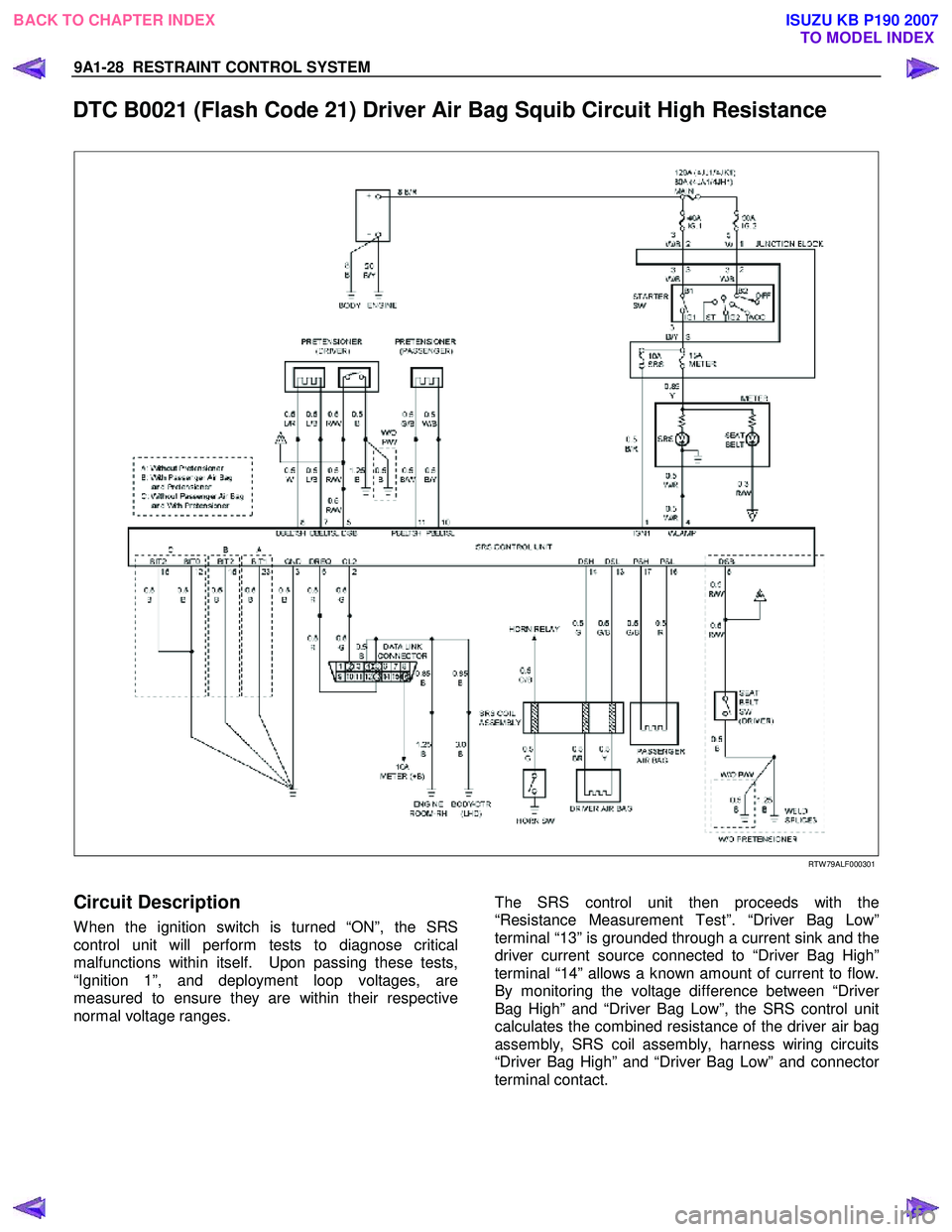
9A1-28 RESTRAINT CONTROL SYSTEM
DTC B0021 (Flash Code 21) Driver Air Bag Squib Circuit High Resistance
RTW 79ALF000301
Circuit Description
W hen the ignition switch is turned “ON”, the SRS
control unit will perform tests to diagnose critical
malfunctions within itself. Upon passing these tests,
“Ignition 1”, and deployment loop voltages, are
measured to ensure they are within their respective
normal voltage ranges.
The SRS control unit then proceeds with the
“Resistance Measurement Test”. “Driver Bag Low”
terminal “13” is grounded through a current sink and the
driver current source connected to “Driver Bag High”
terminal “14” allows a known amount of current to flow.
By monitoring the voltage difference between “Drive
r
Bag High” and “Driver Bag Low”, the SRS control unit
calculates the combined resistance of the driver air bag
assembly, SRS coil assembly, harness wiring circuits
“Driver Bag High” and “Driver Bag Low” and connecto
r
terminal contact.
BACK TO CHAPTER INDEX
TO MODEL INDEX
ISUZU KB P190 2007
Page 5713 of 6020
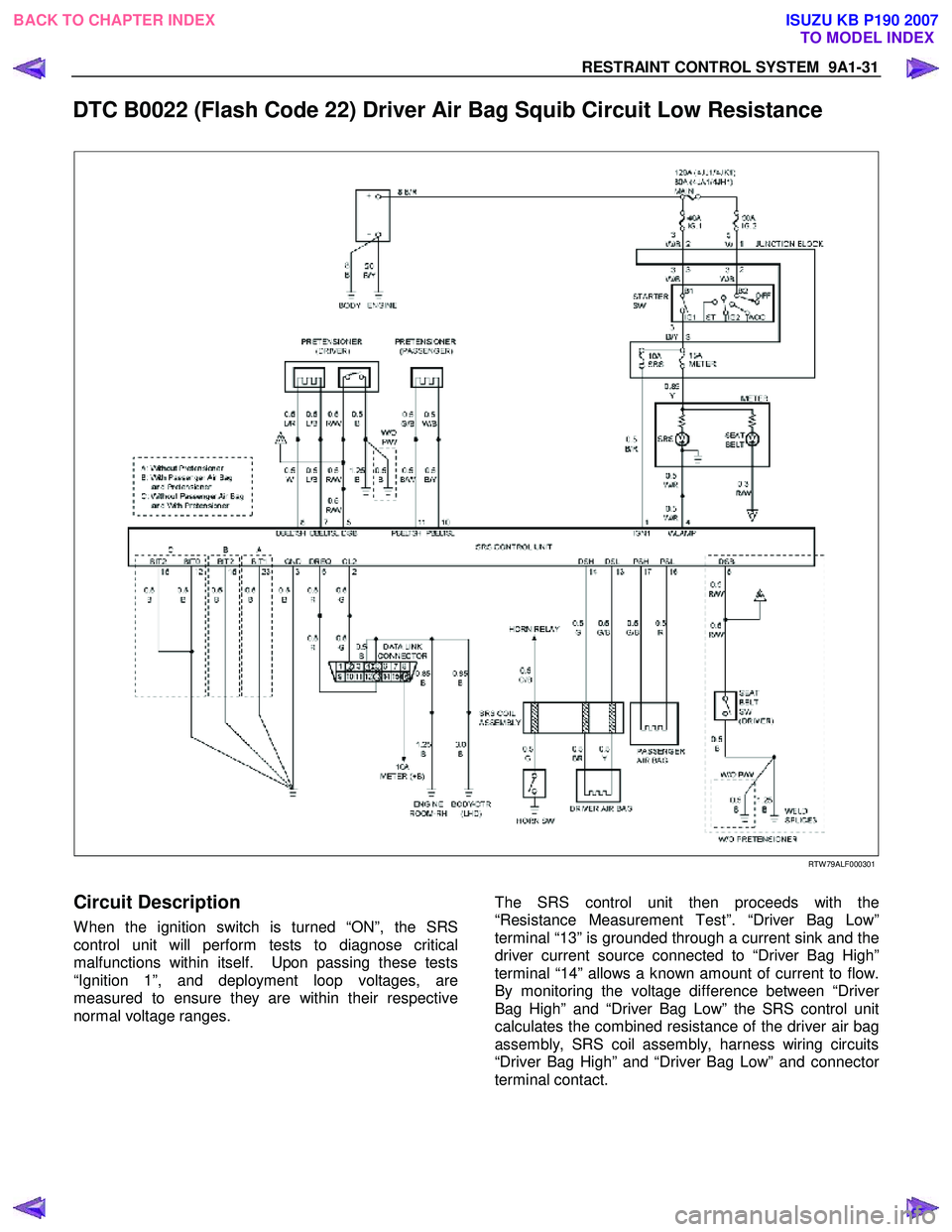
RESTRAINT CONTROL SYSTEM 9A1-31
DTC B0022 (Flash Code 22) Driver Air Bag Squib Circuit Low Resistance
RTW 79ALF000301
Circuit Description
W hen the ignition switch is turned “ON”, the SRS
control unit will perform tests to diagnose critical
malfunctions within itself. Upon passing these tests
“Ignition 1”, and deployment loop voltages, are
measured to ensure they are within their respective
normal voltage ranges.
The SRS control unit then proceeds with the
“Resistance Measurement Test”. “Driver Bag Low”
terminal “13” is grounded through a current sink and the
driver current source connected to “Driver Bag High”
terminal “14” allows a known amount of current to flow.
By monitoring the voltage difference between “Drive
r
Bag High” and “Driver Bag Low” the SRS control unit
calculates the combined resistance of the driver air bag
assembly, SRS coil assembly, harness wiring circuits
“Driver Bag High” and “Driver Bag Low” and connecto
r
terminal contact.
BACK TO CHAPTER INDEX
TO MODEL INDEX
ISUZU KB P190 2007